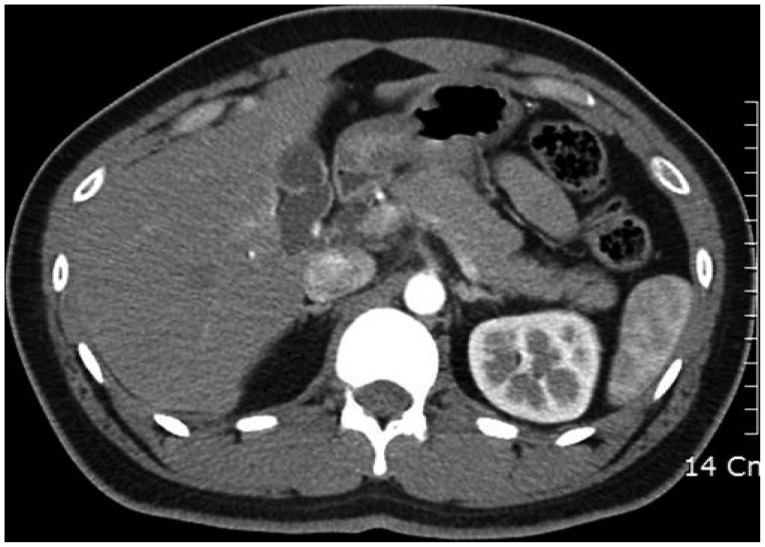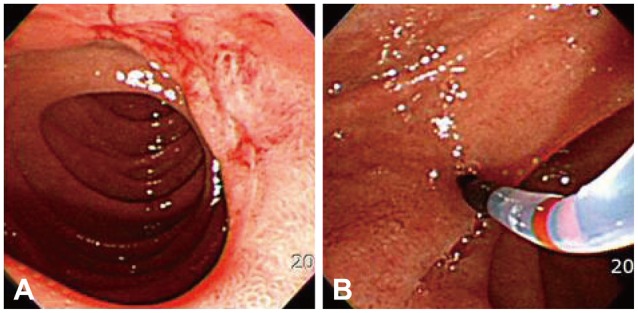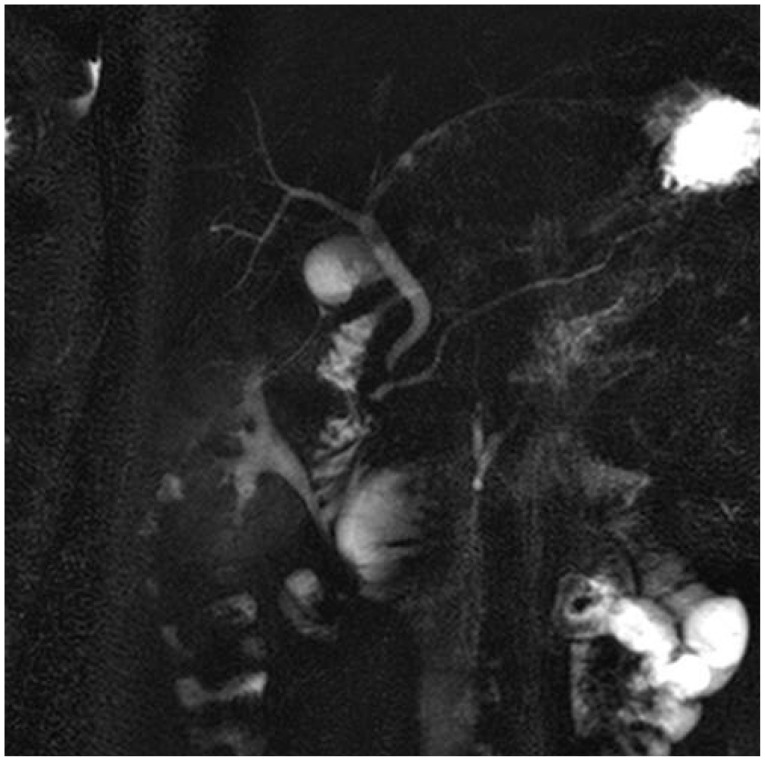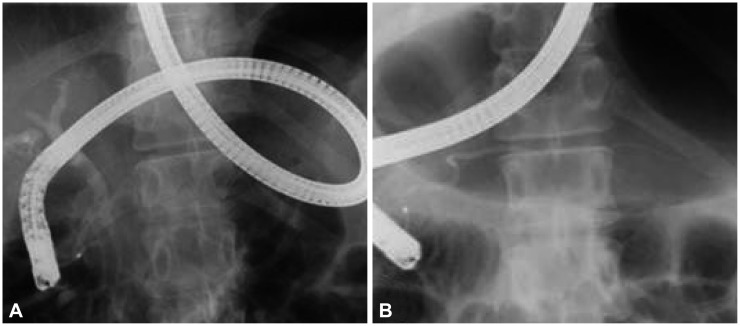Clin Endosc.
2014 Nov;47(6):579-583. 10.5946/ce.2014.47.6.579.
Acute Pancreatitis Due to a Duodenal Ulcer
- Affiliations
-
- 1Department of Internal Medicine, Busan Medical Center, Busan, Korea. asluke@naver.com
- 2Department of Internal Medicine, Seoul National University Hospital, Seoul National University College of Medicine, Seoul, Korea.
- KMID: 2134500
- DOI: http://doi.org/10.5946/ce.2014.47.6.579
Abstract
- Duodenal ulcers and acute pancreatitis are two of the most commonly encountered gastrointestinal diseases among the general population. However, duodenal ulcer-induced pancreatitis is very rarely reported worldwide. This report elaborates on a distinct medical treatment that contributes to partial or complete treatment of acute pancreatitis induced by a duodenal ulcer scar.
Keyword
Figure
Reference
-
1. Kim JI, Kim SG, Kim N, et al. Changing prevalence of upper gastrointestinal disease in 28 893 Koreans from 1995 to 2005. Eur J Gastroenterol Hepatol. 2009; 21:787–793. PMID: 19404205.2. Rodriguez HP, Aston JK, Richardson CT. Ulcers in the descending duodenum. Postbulbar ulcers. Am J Roentgenol Radium Ther Nucl Med. 1973; 119:316–322.3. Al-Bahrani ZR, Kassir ZA, Al-Doree W. The location and multiplicity of chronic duodenal ulcer (a study of 1320 patients in Iraq). Gastroenterol Jpn. 1980; 15:539–542. PMID: 7450386.4. Kim CD. Current status of acute pancreatitis in Korea. Korean J Gastroenterol. 2003; 42:1–11. PMID: 14532725.5. Spanier BW, Dijkgraaf MG, Bruno MJ. Epidemiology, aetiology and outcome of acute and chronic pancreatitis: an update. Best Pract Res Clin Gastroenterol. 2008; 22:45–63. PMID: 18206812.
Article6. Banks PA. Epidemiology, natural history, and predictors of disease outcome in acute and chronic pancreatitis. Gastrointest Endosc. 2002; 56(6 Suppl):S226–S230. PMID: 12447272.
Article7. Yoshida K, Toki F, Takeuchi T, Watanabe S, Shiratori K, Hayashi N. Chronic pancreatitis caused by an autoimmune abnormality. Proposal of the concept of autoimmune pancreatitis. Dig Dis Sci. 1995; 40:1561–1568. PMID: 7628283.8. Garg PK, Khajuria R, Kabra M, Shastri SS. Association of SPINK1 gene mutation and CFTR gene polymorphisms in patients with pancreas divisum presenting with idiopathic pancreatitis. J Clin Gastroenterol. 2009; 43:848–852. PMID: 19593166.
Article9. Weiss FU, Simon P, Bogdanova N, et al. Complete cystic fibrosis transmembrane conductance regulator gene sequencing in patients with idiopathic chronic pancreatitis and controls. Gut. 2005; 54:1456–1460. PMID: 15987793.
Article10. Kota SK, Krishna SV, Lakhtakia S, Modi KD. Metabolic pancreatitis: etiopathogenesis and management. Indian J Endocrinol Metab. 2013; 17:799–805. PMID: 24083160.
Article11. Ribet M, Wurtz A. Duodenal ulcer eroding the papilla. 2 cases. J Chir (Paris). 1983; 120:155–157. PMID: 6863414.12. Bank S, Indaram A. Causes of acute and recurrent pancreatitis. Clinical considerations and clues to diagnosis. Gastroenterol Clin North Am. 1999; 28:571–589. PMID: 10503137.13. Levy MJ, Geenen JE. Idiopathic acute recurrent pancreatitis. Am J Gastroenterol. 2001; 96:2540–2555. PMID: 11569674.
Article14. Wilson C, Imrie CW, Carter DC. Fatal acute pancreatitis. Gut. 1988; 29:782–788. PMID: 3384362.
Article15. Banerjee AK, Kaul A, Bache E, Parberry AC, Doran J, Nicholson ML. An audit of fatal acute pancreatitis. Postgrad Med J. 1995; 71:472–475. PMID: 7567753.
Article16. Vila JJ. Endoscopic ultrasonography and idiopathic acute pancreatitis. World J Gastrointest Endosc. 2010; 2:107–111. PMID: 21160725.
Article17. Ji SB, Lee KJ, Yoo BM, et al. Two cases of anomalous termination of the common bile duct and the pancreatic duct into the duodenal bulb. Korean J Gastrointest Endosc. 1998; 18:637–643.18. Kuo CM, Chiu YC, Changchien CS, et al. Endoscopic papillary balloon dilation for removal of bile duct stones: evaluation of outcomes and complications in 298 patients. J Clin Gastroenterol. 2012; 46:860–864. PMID: 23060218.
- Full Text Links
- Actions
-
Cited
- CITED
-
- Close
- Share
- Similar articles
-
- A Rare Case of Pancreas Divisum Accompanied by Acute Pancreatitis Following Endoscopic Hemostasis for Duodenal Ulcer Bleeding
- A Case of Intramural Duodenal Hematoma Accompanied by Acute Pancreatitis Following Endoscopic Hemostasis for Duodenal Ulcer Bleeding
- Duodenal Bezoar: A Rare Cause of Acute Pancreatitis
- Three Cases of Coexistence of Gastric Cancer and Duodenal Ulcer
- Successful Endoscopic Decompression for Intramural Duodenal Hematoma with Gastric Outlet Obstruction Complicating Acute Pancreatitis







